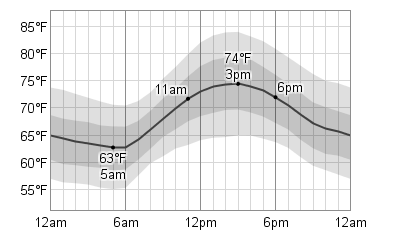
Photograph of the author, taken today.
It’s hot on the East Coast today. Very hot. To the extent that I’m fairly confident that my brain isn’t working properly. The first day of summer is saying, “Hey, everyone! I’m here! Look at me!” Yeah, we see you, summer.
Temperatures in New York and Washington, D.C., are still over 90 degrees F. A local station in Baltimore reported that it was 775 degrees there, but that seems a little high. These are the days when we look wistfully at our air conditioners, appreciating all that they do for us even as we know that we shouldn’t use them, but we use them anyway. (Love you, air conditioner!) (Need tips on buying one? Voila.)
Here’s how the temperatures in New York between yesterday and today compare. (The gap is missing data, probably obviously.)

Here’s a chart of the average temperature for June 20 in New York.

Image courtesy of Weatherspark.com.
Today’s temperature is somewhere above and outside the graph.
In direct correlation, here’s the real-time load on the city’s electrical grid for yesterday and today, via the New York Independent System Operator.

Usage today is a full 25 percent higher than it was yesterday at the same time. That’s a big spike, one that puts strain on electricity providers. And that strain means that Con Edison, our local provider, has issued warnings about brownouts.
Brownouts are drops in available voltage aimed at reducing load. The alternative, in a worst-case scenario, is that the system is overloaded, resulting in unplanned blackouts. Brownouts allow Con Ed to direct where load reductions occur. Blackouts don’t.
Climate change will make heat waves more common. Meaning that spikes in power usage will become more common, or that we’ll need to create a higher baseline of available energy on a day-to-day basis. The EPA makes these predictions about energy use in a warming climate:
Warming is likely to increase summer peak electricity demand in most regions of the United States. Meeting increases in this peak demand could require investments in new energy infrastructure. For example, based on a 6.3 to 9°F temperature increase, climate change could increase the need for additional electric generating capacity by roughly 10-20% by 2050. This would require hundreds of billions of dollars in additional investment.
And, worse:
A warmer climate may reduce the efficiency of power production for many existing fossil fuel and nuclear power plants because these plants use water for cooling. The colder the water, the more efficient the generator. Thus, higher air and water temperatures could reduce the efficiency with which these plants convert fuel into electricity.
So we’ll need more power and be worse at generating it from our fossil fuel- and nuclear-based plants. Super.
If you’ll excuse me, I’m going to go live in my refrigerator until winter. Once I figure out how to make it solar powered.



